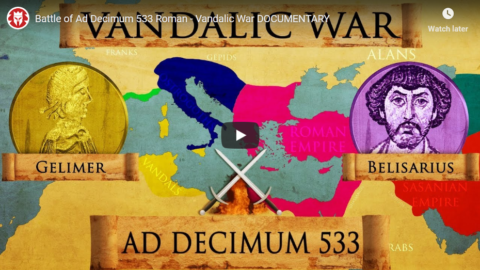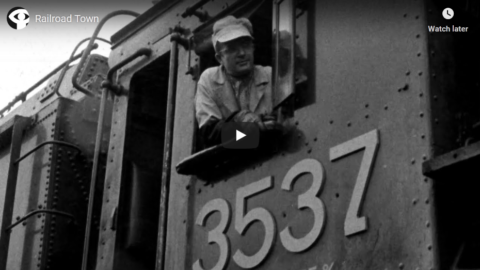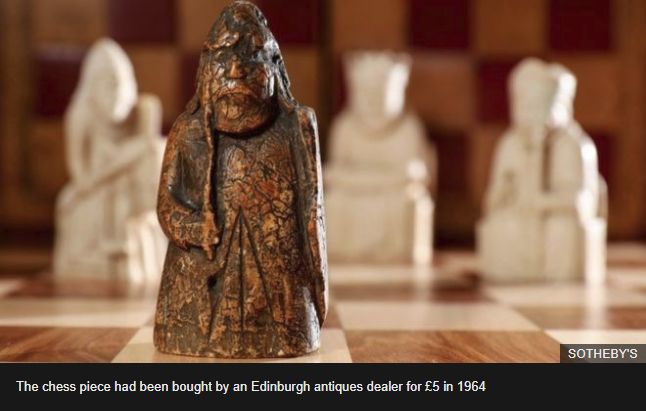When Saving Private Ryan was released in America, I made a mild observation to the effect that its premise was a lot of hooey, and received in response several indignant letters pointing out that it was “based on a true story”, that of the Sullivan brothers. Er, not quite. The Sullivans’ story is stirringly told in The Fighting Sullivans (1942, directed by 42nd Street’s Lloyd Bacon): after Pearl Harbor, all five brothers enlist — and all five die aboard the [cruiser] Juneau at Guadalcanal. As a result, to avoid the recurrence of such a freakish tragedy, the United States changed its policy on family members serving together. Steven Spielberg’s film is not “based” on the Sullivans, except insofar as General George C. Marshall, the US Army’s chief of staff, mentions their fate to explain his decision.
Rather, the film is a kind of extension of the thinking behind the policy change: when three out of four Ryan brothers are killed in action, General Marshall orders a rescue mission to retrieve the sole surviving sibling, whose general whereabouts are somewhere behind enemy lines in Normandy — and all this a couple of days after D-Day. No such incident took place: no Allied commander would have thought it worth the risk in lives to assuage one distraught mother’s potential further bereavement.
Spielberg’s mistake is that, as one of the last remaining hardcore Clinton groupies, he’s thinking in Clintonian terms — about publicity, image, spin: the death of another Ryan brother would not “look good”. When Spielberg has General Marshall read out a letter from Lincoln to a mother whose sons all died in the Civil War, we’re certainly meant to find his consoling words — that they gave their lives in a great and noble cause — inadequate. It’s a measure of the gulf between 1944 and 1998 that The Fighting Sullivans was released during the war because it was thought the supreme sacrifice of one family would be inspiring. Alas, not to baby boomers.
So much has been written about the unprecedented “realism” of this film’s war scenes that the equally unprecedented unrealism of its thinking has passed virtually unnoticed. You’ve probably seen a zillion articles about the film’s prologue — a recreation of D-Day which lasts almost as long and doubtless cost a lot more — so I’ll say only this: yes, it’s impressive; yes, every shot of blood and tissue and body parts is underlined by adroit effects; yes, every moment is a testament to Spielberg’s command of cinematic technique; but that’s the problem — you react to it as technique, as showmanship. There’s one perfect shot after another: the silence underwater, with its dangerous illusion of respite; the pitterpatter of rain on leaves gradually blurring into rifle fire. The whole thing is oddly pointless: you’re not engaged by the predicament of the troops because you’re so busy admiring the great film-maker behind them. A film cannot really be “authentic” if all you notice is the authenticity.
Mark Steyn, The Spectator, 1998-09-12 (linked from SteynOnline).
June 6, 2019
QotD: Reviewing Saving Private Ryan
June 5, 2019
Sensible proposals from the copyright review report
Michael Geist summarizes the — seemingly quite sensible — recommendations from the copyright review process:
In December 2017, the government launched its copyright review with a Parliamentary motion to send the review to the Standing Committee on Industry, Science and Technology. After months of study and hundreds of witnesses and briefs, the committee released the authoritative review with 36 recommendations [PDF] that include expanding fair dealing, a rejection of a site blocking system, and a rejection of proposals to exclude education from fair dealing where a licence is otherwise available. The report represents a near-total repudiation of the one-sided Canadian Heritage report that was tasked with studying remuneration models to assist the actual copyright review. While virtually all stakeholders will find aspects they agree or disagree with, that is the hallmark of a more balanced approach to copyright reform.
This post highlights some of the most notable recommendations in the report that are likely to serve as the starting point for any future copyright reform efforts. There is a lot here but the key takeaways on the committee recommendations:
- expansion of fair dealing by making the current list of fair dealing purposes illustrative rather than exhaustive (the “such as” approach)
- rejection of new limits on educational fair dealing with further study in three years
- retention of existing Internet safe harbour rules
- rejection of the FairPlay site blocking proposal with insistence that any blocking include court oversight
- expansion of the anti-circumvention rules by permitting circumvention of digital locks for purposes that are lawful (ie. permit circumvention to exercise fair dealing rights)
- extend the term of copyright only if ratifying the USCMA and include a registration requirement for the additional 20 years
- implement a new informational analysis exception
- further study of statutory damages for all copyright collectives along with greater transparency
- adoption of an open licence rather than the abolition of crown copyright
My submission to the Industry committee can be found here. The submission and my appearance is cited multiple times in the report and I’m grateful that the committee took the submissions from all witnesses seriously.
The four equal-ish regions of Canada
On Reddit, u/the_vizir posted an interesting illustration of Canada divided into four regions of (approximately) equal population, based on the 2015 electoral map:
I used this map of Canada’s Federal ridings by DrRandomFactor as a base. Then I attempted to mirror the original map’s divisions, tallying up the populations of the ridings, as based on this chart from Wikipedia.
Ultimately, the original map proved to be rather accurate in the West, but in the East it was off by quite a bit. Despite my best attempts, I could not get the entire Quebec City to Windsor corridor into two geographically contiguous regions. And so Windsor ultimately got shunted into the Great Orange North.
Interestingly, in terms of ridings, the four regions are also rather equal — which one might consider surprising given the population disparity between the largest and smallest ridings (the least populous riding, Labrador, has 27k people; while Brantford-Brant, the most populous, has 132k). However, in the end, the red region has 80 ridings, the green region 83, the purple region 86 and the orange region 89.
The 25 most populous urban areas within that large, orange region include:
- Halifax, NS — 404k
- Windsor, ON — 392k
- St. John’s, NL — 205k
- Barrie, ON — 197k
- Sudbury, ON — 165k
- Saguenay, PQ — 161k
- Moncton, NB — 145k
- Saint John, NB — 126k
- Thunder Bay, ON –121k
- Chatham-Kent, ON — 102k
- Fredericton, NB –102k
- Cape Breton, NS — 99k
- Sarnia, ON – 96k
- Prince George, BC — 86k
- Sault Ste. Marie, ON — 78k
- Fort McMurray. AB — 73k
- North Bay, ON — 70k
- Charlottetown, PE — 69k
- Grande Prairie, AB — 63k
- Rimouski, PQ — 55k
- Shawinigan, PQ — 54k
- Leamington, ON — 49k
- Truro, NS — 46k
- Prince Albert, SK — 44k
- Rouyn-Noranda, PQ — 42k
Somewhat surprisingly, even on this list, no communities in the Territories make the cut. The largest urban area in the North, Whitehorse, is still only 39th on this list, between Fort St. John, BC and Baie-Comeau, PQ. Yellowknife is 48th, between North Battleford, SK and Yorkton, SK.
The smallest riding in the orange area is Charlottetown at 46 sq. km, followed by Windsor West at 83 sq. km and Dartmouth-Cole Harbour at 102 sq. km. The largest riding in one of the other regions is Cypress Hills-Grasslands at 77,822 sq. km, followed by Kootenay-Columbia at 60,405 sq. km and Souris-Moose Mountain at 43,184 sq. km. All of these were in the purple region and were, unfortunately, necessary to bridge Winnipeg to the Calgary-Edmonton corridor, and then the Calgary-Edmonton corridor to the Lower Mainland.
(To those just looking for random facts: the smallest riding of them all is Toronto Centre, at 6 sq. km, followed by Papineau at 10 sq. km and both Laurier-Sainte-Marie and Rosemont-La Petite-Patrie at 11 sq. km each. The largest ones are Nunavut at 2,093,190 sq. km, Northwest Territories at 1,346,106 sq. km and Abitibi-Baie-James-Nunavik-Eeyou at 854,754 sq. km. And no, that last one doesn’t have the longest riding name. That would be Leeds-Grenville-Thousand Islands and Rideau Lakes, coming in at 49 characters and beating out the previous champion, West Vancouver-Sunshine Coast-Sea to Sky Country).
H/T to halls of macademia for the link.
Battle of Ad Decimum 533 Roman – Vandalic War Documentary
Kings and Generals
Published on 12 Nov 2017Although Belisarius, the best general of the Roman Emperor Justinian, had earned a significant victory over the Sassanids at the battle of Dara in 530, the restoration of the empire was just starting. The empire’s western lands were under Vandalic control and Justinian was eager to get them back. He sent Belisarius to Africa to deal with the Vandals. Two battles – Ad Decimum and Tricamarum – were central in this campaign.
Previous video within this series – Battle of Dara 530: https://www.youtube.com/watch?v=9GR_V…
Support us on Patreon: http://www.patreon.com/KingsandGenerals or Paypal: http://paypal.me/kingsandgenerals
We are grateful to our patrons, who made this video possible: Koopinator, Daisho, Łukasz Maliszewski, Nicolas Quinones, William Fluit, Juan Camilo Rodriguez, Murray Dubs, Dimitris Valurdos, Félix Gagné-Dion, Fahri Dashwali, Kyle Hooton, Dan Mullen, Mohamed Thair, Pablo Aparicio Martínez, Iulian Margeloiu, Chet, Nick Nasad, Jeyares, Amir Eppel, Thomas Bloch, Uri Sternfeld, Juha Mäkelä, Georgi Kirilov, Moe Mia, Daniel Yifrach, Brian Crane, Muramasa, Gerald Tnay, Hassan Ali, Richie Thierry, David O’Hare, Christopher Commins, Chris Glantzis and Mike.
The script was developed by our friend DismountedCentaur. His help with the research was essential for this documentary.
This video was narrated by good friend Officially Devin. Check out his channel for some kick-ass Let’s Plays. https://www.youtube.com/user/Official…
The Machinimas for this video are created by one more friend – Malay Archer. Check out his channel, he has some of the best Total War machinimas ever created: https://www.youtube.com/user/Mathemed…
The National Inquiry into Missing and Murdered Indigenous Women and Girls
In the National Post, Chris Selley points out some odd blindspots in the final report of the National Inquiry into Missing and Murdered Indigenous Women and Girls:
“The violence the National Inquiry heard amounts to a race-based genocide of Indigenous Peoples, including First Nations, Inuit and Métis, which especially targets women, girls, and 2SLGBTQQIA people,” the report declares. Among the first headlines was one noting that Prime Minister Justin Trudeau “avoided” using the G-word in his remarks on its findings, settling for “shameful” and “unacceptable.”
The inquiry’s legal analysis concedes it is a novel deployment of the term. It seems far more comfortable alleging a historical genocide against “Indigenous Peoples” that involved specific targeting of women — for example through forced sterilization, which is acknowledged as a genocidal technique in the 1948 UN convention — than it does a genocide against Indigenous women and girls specifically. But the insistence upon the term speaks volumes about this peculiar inquiry’s tortured birth, and about some of its more perplexing recommendations.
Indigenous women have certainly been targets for violence and discrimination in particular ways throughout Canada’s history. Today they suffer disproportionately from violent crime, relative to Indigenous men, in a way that non-Indigenous women do not. The rate of self-reported sexual assault among Indigenous women in the 2014 General Social Survey (GSS) was more than triple that of non-Indigenous women. An astonishing 61 per cent of Indigenous women aged 15-25 reported violent victimization in the previous 12 months — nearly six times the rate for Indigenous men the same age.
But if Indigenous victims of violence even today can be said to be casualties of colonialist genocide, then the subset who are by far the most “especially targeted” — which is to say dead — are men. Between 2014 and 2017, Statistics Canada reports there were 139 Indigenous female homicide victims, and 428 Indigenous male victims — three times as many. (Similarly, non-Indigenous men were murdered two-and-a-half times more often than non-Indigenous women.)
[…]
But the obsession with half the Indigenous population leads to some bewildering recommendations, especially on the justice file. On the one hand the report inveighs against mandatory minimum sentences as a cause of Indigenous overrepresentation in the prison system, and calls for more robust applications of Gladue principles for all Indigenous offenders, which is to say more alternatives to incarceration; on the other hand it supports legislation that would require judges to punish violent offences more harshly if the victim is an Indigenous woman, and to automatically classify homicides occurring after “a pattern of intimate partner violence and abuse” as first-degree murder. This would almost certainly have the effect of increasing the incarceration rates of Indigenous men and women alike.
WWII Field Kitchen Overview
Tri-State Living History Association
Published on 15 Dec 2018The GI Field Kitchen during WWII was part of the Company HQ, designed to serve 150-180 men. They intended to serve 2 hot meals per day: Breakfast & Supper, with Dinner (Lunch) as a combat ration. They were equipped with stoves, water heaters and mermite cans to deliver the hot food to the troops.
While sound in theory, often times in reality the kitchens had to make do with less equipment and were forced to adapt to the situations in which they were forced to operate. Despite this, mess staff did their best to keep the fighting man’s body and morale fed.
Filmed at Rockford WWII Days 2018
Special thanks to Nick Yi Photography: https://www.nickyi.com/
Website: https://www.tslha.org/
Print Sources:
TM 10-405 (Apr 24, 1942) – The Army Cook
TM 10-406 (Nov 22, 1943) – Cooking Dehydrated Foods
TM 10-400 (Nov, 1944) – Stoves, Ranges, Ovens, and Cooking Outfits
TM 10-701 (Dec, 1945) – Range, Field M-1937
T/O 7-17 (Sept 1, 1942): http://www.hardscrabblefarm.com/ww2/
Footage Sources:
The Battle of San Pietro – John Huston (1945)
TF 10-1237 – Rations in the Combat Zone Part 1 – Fighting Food
TF 10-1215 – Rations in the Combat Zone Part 2 – Unit Messing
TF 10-2454 – Unit Messing in the Field
TF 10-1202 – Baking in the Field Part 1 – The M1942 Field Baking Unit
MISC 1282 – Quartermaster Activities in the European Theater
Picture Sources: 185th Field Artillery, 34th ID from the H. Smith collection: http://34thinfantry.com/photos.html
QotD: The almost unknown economic good news since 1800
Ordinary people, and some economists, and even a few economic historians, don’t know it. Hans Rosling, the late, great Swedish professor of public health, emphasized how little most people, even very well-informed people, know about the overwhelmingly good news 1800 to the present, or even 1960 to the present (e.g., falling birth rates, falling infant death rates, rising literacy). He surveyed people, in his various audiences to the number of 20,000. They were embarrassingly less accurate on the whole than monkeys would be throwing darts at the multiple choice possibilities. And the human experts, with ordinary citizens, were always biased in a pessimistic, anti-modern direction. Consider Kenneth Pomeranz, in his fine book with Steven Topik, The World That Trade Created. Pomeranz and Topik tell many interesting and accurate stories about the bad side of creative destruction (which comes from any human progress, not as is often said on the left from “neo-liberalism”). But they never acknowledge the gigantic improvements coming from it for ordinary people. Not once.
Dierdre McCloskey, “How Growth Happens: Liberalism, Innovism, and the Great Enrichment (Preliminary version)” [PDF], 2018-11-29.
June 4, 2019
What do you get for your tax money?
Alex Noble conducts a small experiment:

“Murderous Pothole”by samsaundersleeds is licensed under CC BY-SA 2.0
I suggest we stop thinking about taxes as paying for something useful – this type of thinking paralyses us and causes us to refuse to do that which needs doing. Because our taxes are supposed to pay for it.
We are no longer charitable, because our taxes pay for dole money.
We no longer look after the verge outside our homes, because our taxes are supposed to pay for a council worker with a strimmer.
We don’t repair potholes in our roads, because council workmen are supposed to fill them in.Just to check that last one, I contacted my local council.
“I was wondering if I could personally pay a local company to make repairs to the potholes that are causing damage to my car out of my money, and if so, would they be granted permission to close the road while my privately-funded repairs were being carried out?”
And they said…………
“It would not be possible for you undertake these repairs, and no permission would be given to close the road.”
So I proposed I make a payment to them, to be spent on repairing the road:
“…could I instead make a voluntary tax contribution on the condition the money is to be spent on these road repairs?”
And they said…
“…the County Council will not accept payment from members of the public for the provision of highway maintenance over and above that already collected via the Council Tax”
I made one last attempt…
“I have obtained quotes for the work which are acceptable to me and my neighbours – is there really no way we can as private individuals simply pay for the repairs to our road?”
They responded:
“…it is not possible to accept any from of funding other than that accepted via the Council Tax and Central Government.”
So I just went out and bought a bag of sand and pounded it into the hole one night. A temporary fix, admittedly.
£5 of sand and five minutes of my time.
No doubt the council are scouring CCTV as we speak in an attempt to bring to justice the criminal that repaired the road.
Railroad Town
NFB
Published on 7 Aug 2017This short documentary is a delightful trip back to an era in which railroad was king.
Directed by Don Haldane
About the NFB
The National Film Board of Canada produces and distributes documentary films, animation, web documentaries and fiction. Our stories explore the world we live in from a Canadian point of view.Watch over 3,000 films for free on NFB.ca – http://bit.ly/YThpNFB
Want more? Sign up for our newsletter – http://bit.ly/YTnwNFBConnect with the NFB online:
Twitter: http://bit.ly/yttwNFB
Missing Isle of Lewis chess piece discovered in Edinburgh
It’s always irritating when you lose a chess piece, but this one’s been missing for a long, long time:
A medieval chess piece that was missing for almost 200 years had been unknowingly kept in a drawer by an Edinburgh family.
They had no idea that the object was one of the long-lost Lewis Chessmen – which could now fetch £1m at auction.
The chessmen were found on the Isle of Lewis in 1831 but the whereabouts of five pieces have remained a mystery.
The Edinburgh family’s grandfather, an antiques dealer, had bought the chess piece for £5 in 1964.
He had no idea of the significance of the 8.8cm piece (3.5in), made from walrus ivory, which he passed down to his family.
They have looked after it for 55 years without realising its importance, before taking it to Sotheby’s auction house in London.
The Lewis Chessmen are among the biggest draws at the British Museum and the National Museum of Scotland in Edinburgh.
They are seen as an “important symbol of European civilisation” and have also seeped into popular culture, inspiring everything from children’s show Noggin The Nog to part of the plot in Harry Potter And The Philosopher’s Stone.
Sotheby’s expert Alexander Kader, who examined the piece for the family, said his “jaw dropped” when he realised what they had in their possession.
H/T to Colby Cosh for the link.
Original Vietnam-Era M60 at the Range
Forgotten Weapons
Published on 27 Apr 2019http://www.patreon.com/ForgottenWeapons
Cool Forgotten Weapons merch! http://shop.bbtv.com/collections/forg…
The M60 was the first modern American military machine gun, developed from the operating system of the German FG-42 and the feed system of the German MG-42 in the years after World War Two. It has a rather schizophrenic reputation, being loved by many who used it in Vietnam and hated by many who used it later in its service life. The design had some fundamental flaws, but did offer a far more mobile base of fire than the M1919A6 that it replaced. Today, I am going to do a bit of shooting with an original Vietnam pattens M60, which will act as a baseline for future videos covering the various improvements and modernizations of the platform.
Thanks to the Institute of Military Technology (https://www.instmiltech.com) for giving me the opportunity to bring this M60 on camera for you!
Contact:
Forgotten Weapons
PO Box 87647
Tucson, AZ 85754
QotD: Freedom of speech and “balancing” competing rights
“They used to pay lip service to the Voltaire argument,” [“I disagree with what you say, but will defend to the death your right to say it”] says Steyn, “but now they say that every other right trumps freedom of speech. The rights of identity groups take precedence. Since there is no document in the British Commonwealth to support free-speech absolutism, as you have in the United States, what’s happened in our time is that there is a view of competing rights. Section 13 in Canada. Section 18 in Australia. Human rights commissions everywhere. And it’s all done in the name of ‘striking a balance’. The minute you talk about striking a balance, you are on the wrong side of the line, because that cure is worse than the disease. We have to take chances with repellent and repulsive speech in order to retain free speech.
“And actually it’s no better in the United States. On the one hand you have the absence of a monarchy and free-speech absolutism, but on the other hand you prostrate yourselves before judges. I’m in the fifth year of a lawsuit that started with a 140-word blog post — there’s not much of a First Amendment when that happens. And then, on your college campuses, you have the debate about ‘acceptable’ and ‘safe’ speech. You have a tiny little Canada on each campus, with the same sort of shrunken, shrivelled public discussion. ‘Safe speech’ is a road to hell. Their goal is the abolition of hate — the abolition of a human emotion. They want everyone to have this glassy-eyed look, celebrating diversity. And they don’t recognise their own totalitarianism.”
Mark Steyn, interviewed by John Bloom, “Mark Steyn, Cole Porter and Free Speech”, Quadrant, 2017-05-11.
June 3, 2019
The Hare of Inaba – Japanese Myth – Extra Mythology
Extra Credits
Published on 1 Jun 2019Join the Patreon community! http://bit.ly/EMPatreon
A small white hare stood alone on the Isle of Oki, yearning to cross the deep waters to Japan. He was a clever hare — crafty, if not always wise — and he had a plan.
Thumbnail image for social media:
The state of US academia in juxtaposed tweets
American universities have problems, but the solutions they choose do not seem to be addressing those problems (screencapped, in case the tweet doesn’t load correctly):















